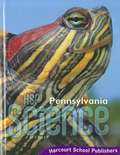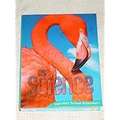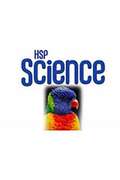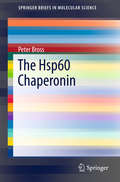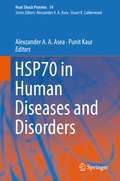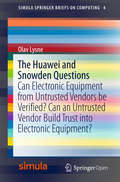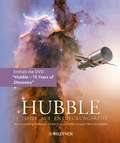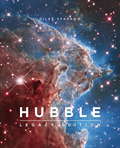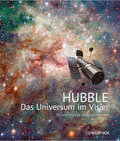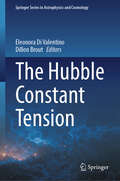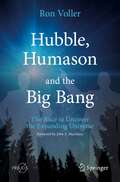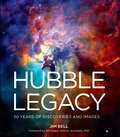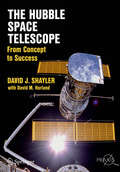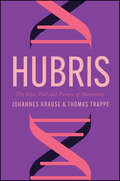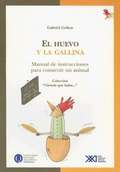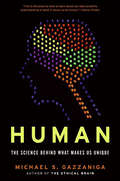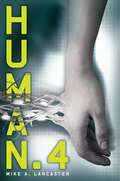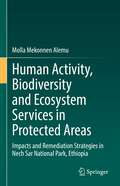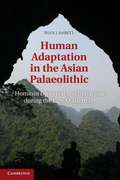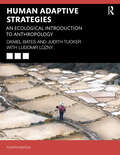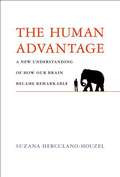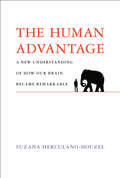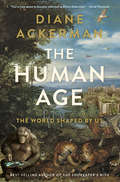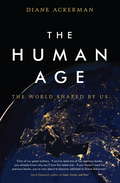- Table View
- List View
HSP Science, Grade 4
by Harcourt School PublishersA textbook on Life Science, Earth Science, and Physical Science.
The Hsp60 Chaperonin
by Peter BrossIn this unique overview of the Hsp60 chaperonin, Peter Bross addresses molecular biologists, medical research scientists and individuals interested in molecular or general biology. First, Bross discusses the basics of the Hsp60 chaperonin in terms of its structure and the molecular mechanisms determining its function. Second, the author highlights the multiple roles of Hsp60 for cellular systems and regulatory pathways, especially in connection with neurodegenerative diseases caused by Hsp60 deficiency. Finally, the author highlights controversial observations suggesting additional, non-standard functions of Hsp60 in and outside mitochondria as well as possible gaps in our understanding of the chaperonin. This volume serves as a snapshot suitable for experienced researcher working in fields related to molecular chaperones yet still accessible to researchers entering the field.
HSP70 in Human Diseases and Disorders (Heat Shock Proteins #14)
by Alexzander A. Asea Punit KaurThe book HSP70 in Human Diseases and Disorders provides the most comprehensive review on contemporary knowledge on the role of HSP70 family - one of the most studied HSP - in human diseases and disorders. Using an integrative approach to expand our current understanding of HSP70 functions, the contributors provide a synopsis of novel mechanisms by which HSP70 is involved in the regulation of human diseases and disorders. Key basic and clinical research laboratories from major universities and academic medical hospitals around the world contribute chapters that review present research activity and importantly project the field into the future. The book is a must read for medical students and residents, clinical and basic science researchers, postdoctoral fellows and graduate students in the fields of Medicine, Physiology, Clinical Trials, Biotechnology, Molecular Medicine and Pathology.
The Huawei and Snowden Questions
by Olav LysneThis open access book answers two central questions: firstly, is it at all possible to verify electronic equipment procured from untrusted vendors? Secondly, can I build trust into my products in such a way that I support verification by untrusting customers? In separate chapters the book takes readers through the state of the art in fields of computer science that can shed light on these questions. In a concluding chapter it discusses realistic ways forward. In discussions on cyber security, there is a tacit assumption that the manufacturer of equipment will collaborate with the user of the equipment to stop third-party wrongdoers. The Snowden files and recent deliberations on the use of Chinese equipment in the critical infrastructures of western countries have changed this. The discourse in both cases revolves around what malevolent manufacturers can do to harm their own customers, and the importance of the matter is on par with questions of national security.This book is of great interest to ICT and security professionals who need a clear understanding of the two questions posed in the subtitle, and to decision-makers in industry, national bodies and nation states.
Hubble: 15 Jahre auf Entdeckungsreise
by Robert Fosbury Lars Lindberg Christensen Martin KornmesserDas Buch ist Teil der Aktivitäten der ESA, der Europäischen Raumfahrtagentur, anlässlich des 15. Geburtstages des Hubble Weltraumteleskops. Dieses Teleskop ist eines der bekanntesten, populärsten Wissenschaftsgeräte überhaupt, nicht zuletzt durch die spektakulären Bilder in Printmedien. Dieses Werk enthält prachtvolle Bilder zu diversen Phänomenen des Kosmos, erklärt durch kurze, verständliche Texte. Eine DVD mit umfangreichem Bild- und Filmmaterial ergänzt das Werk.
Hubble: Window on the Universe
by Giles SparrowFor 20 years the Hubble Space Telescope has been hurtling around our planet at 17,500 mph sending spectacularly sharp images of the universe back to Earth. Hubble is a visual celebration of this large and versatile telescope's astonishing scientific and technical achievements. This fully revised and updated edition of Hubble: Window on the Universe (Legacy Edition) showcases the very latest and clearest images of galaxies, nebulae, quasars, exploding stars and stellar nurseries. More than 200 remarkable cosmic images reveal the inner workings of the solar system, the expansion of the Universe, the birth and death of stars, the formation of planetary nebulae, the dynamics of galaxies and the mysterious force known as 'dark energy'. Featuring the history of the project from its origins and launch in 1990, the discovery and emergency repair of a defective mirror, the impact of subsequent servicing missions and finally, its extraordinary legacy this stunning giant volume will take you on a journey through the universe via 200 glorious full-colour images.
The Hubble Constant Tension (Springer Series in Astrophysics and Cosmology)
by Eleonora Di Valentino Dillon BroutThis book presents the first comprehensive exploration of the state of this well studied and thus unsolved mystery of the value of the Hubble constant. Chapters covering data, systematics, independent methodologies, and theoretical explanations are authored by distinguished subject-matter experts. Tailored for scientists in the field or adjacent fields, this book provides a resource of insights and also an in-depth background sufficient for motivating future study. Key Features: Introduction: Written by the Nobel Laureate Adam Riess. Measurement Techniques: Gain a profound understanding of the leading Hubble constant measurement techniques, from parallax and masers to supernovae and cosmic chronometers, dissected by leading authorities on each. Systematic Errors: A deep dive into the complexities of data. Experts scrutinize potential sources of systematics that may contribute to the observed disagreements, offering a nuanced view of the challenges in Hubble constant determinations. Theoretical Explanations and Progress: A review of the theoretical explanations, some that are still standing, and some that have been ruled out; all of which have led to scientific progress toward the truth. A Comprehensive Take: This book covers every key and influential aspect to the dilemma of the Hubble tension to date and has gathered world-leading voices on each respective topic.
Hubble, Humason and the Big Bang: The Race to Uncover the Expanding Universe (Springer Praxis Books)
by Ron VollerThe story of Hubble and Humason is one for the ages—and in particular, the Cosmic Age. In this compelling book, science writer Ron Voller digs deep into how and why the two scientists continued to investigate their theory of universal expansion in the face of persistent doubt, contrary theories, and calamitous world events. The evolution of this dynamic duo’s tenuous friendship and professional partnership is in many ways as intriguing as their groundbreaking work on the evolution of the universe. The book therefore traces their lives from their childhoods into their burgeoning careers, revealing how a World War and their own personal differences stood in the way of initial cooperation. It then shows how despite all this, the two opposites eventually came together in the pursuit of something far greater than themselves. This grand story is inextricably interwoven with that of Albert Einstein, Willem de Sitter, and other great physicists of the era, all of whom took part in the staggering quest to make sense of the Big Bang and what followed. “Edwin Hubble has often been considered as an island of sorts—a lone wolf of astronomy. But Voller’s book shows otherwise, as he examines Milt Humason’s essential contributions to our understanding of the expanding universe.” - Daniel Lewis, Dibner Senior Curator, History of Science & Technology, The Huntington Library
Hubble Legacy: 30 Years of Discoveries and Images
by Jim BellThis is the definitive book on the Hubble Space Telescope, written by noted astronomer Jim Bell. Looking deep into space, by definition, means looking back in time—and the Hubble Space Telescope can look very far back, including at stars, nebulae, and galaxies that are millions, even billions, of years old. If there is a single legacy of Hubble as it turns 30 years old and nears the end of its useful life, it is this: It has done more to chronicle the origin and evolution of the known universe than any other instrument ever created. Hubble has also captured an astounding collection of ultraviolet images that include geysers of solar light, Mars&’ famous dust storms, exploding stars, solar flares, globular clusters, and actual galaxies colliding. As for scientific milestones, Hubble has helped us learn that the universe is 13.8 billion years old, that just about every large galaxy features a black hole at its center, and that it's possible to create 3-D maps of dark matter. Hubble Legacy will not only feature the most stunning imagery captured by the telescope, but also explain how Hubble has advanced our understanding of the universe and our very creation.
The Hubble Space Telescope
by David J. Shayler David M. HarlandThe highly successful Hubble Space Telescope was meant to change our view and understanding of the universe. Within weeks of its launch in 1990, however, the space community was shocked to find out that the primary mirror of the telescope was flawed. It was only the skills of scientists and engineers on the ground and the daring talents of astronauts sent to service the telescope in December 1993 that saved the mission. For over two decades NASA had developed the capabilities to service a payload in orbit. This involved numerous studies and the creation of a ground-based infrastructure to support the challenging missions. Unique tools and EVA hardware supported the skills developed in crew training that then enabled astronauts to complete a demanding series of spacewalks. Drawing upon first hand interviews with those closely involved in the project over thirty years ago this story explains the development of the servicing mission concept and the hurdles that had to be overcome to not only launch the telescope but also to mount the first servicing mission - a mission that restored the telescope to full working order three years after its launch, saved the reputation of NASA, and truly opened a new age in understanding of our place in space. This is not just a tale of space age technology, astronauts and astronomy. It is also a story of an audacious scientific vision, and the human ingenuity and determination to overcome all obstacles to make it possible. Hubble Space Telescope: From Concept to Success is a story of an international partnership, dedicated teamwork and a perfect blend of human and robotic space operations that will inspire people of all ages. The subsequent servicing missions that enabled the telescope to continue its scientific program beyond its 25th year in orbit are described in a companion volume Enhancing Hubble's Vision: Servicing a National Treasure.
Hubris: The Rise, Fall, and Future of Humanity
by Johannes Krause Thomas TrappeHumans are the most intelligent beings this planet has ever produced. But how is it that we can travel into space, cure diseases and decode the fundamentals of life and, at the same time, find ourselves faced with an existential crisis that threatens to overwhelm us? What lies behind this uncharacteristic failure to master the most important challenge of our existence? In this compelling book, the leading archaeogeneticist Johannes Krause and journalist Thomas Trappe investigate what DNA can tell us about how we got to where we are and what our future might be. They show how the first humans were defeated again and again and suffered fatal setbacks, and how Homo sapiens succeeded in conquering continents, overcoming natural borders and bringing other species under their control. But the genetic blueprint that enabled us to get to where we are today had one flaw: it didn’t factor in planetary boundaries. Now that we are approaching those boundaries for the first time after millions of years of evolution, an urgent question arises: can we learn to live within the available planetary limits, or are we doomed by our DNA to continue to expand, consume, and absorb the resources around us to the point of exhaustion, consigning ourselves and other species to extinction? Has our seemingly unstoppable rise met its ultimate end? While the looming climate crisis does not augur well for humanity’s capacity to adapt to the new situation in which we find ourselves, we are not at the mercy of our DNA – or, at least, we don’t have to be. But can we harness the lessons of the past to survive the present?
El huevo y la gallina Manual para construir un animal
by Gabriel Gellon"La gallina es la forma que tiene el huevo para hacer otro huevo", supo decir Samuel Butler. Y es una explicación tan buena como cualquier otra o, al menos, es una respuesta posible a uno de los mayores desafíos de la biología moderna. Porque pese a los enormes avances en biología molecular y en la traducción de esa maraña que es el genoma humano, hay dos cuestiones fundamentales para las que recién estamos vislumbrando las preguntas (que para las respuestas, ya habrá tiempo): cómo funciona el cerebro y, sobre todo, cómo a partir de una célula de mamá y papá, se llega a un embrión y a un bebé sapo, bebé gallina, bebé lombriz o bebé humano. Las preguntas son fascinantes: ¿cómo a partir de una única célula se llega a un organismo entero, con partes y funciones tan diferentes entre sí? ¿Cómo "sabe" un embrión qué genes tiene que encender o apagar a lo largo de su desarrollo? ¿Por qué tenemos la cabeza en la cabeza y la cola en la cola, y no al revés? En éste libro lleno de éstas y otras preguntas maravillosas, Gabriel Gellon nos lleva a través de las posibles respuestas, como un guía con el que recorremos las historia de las ideas y los experimentos de la biología del desarrollo. Así, nos sorprendemos junto con Aristóteles al mirar lo que pasa dentro de los huevos, exploramos el manual de instrucciones que llevamos dentro y nos emocionamos al entender cómo se va formando una mosquita pequeña, tan dulce ella. Y si algún lector se desilusiona frente a la ausencia de cigüeñas o repollos, tendrá muchas más historias maravillosas (y reales) con las que asombrarse y quedarse pensando en todo lo que pasó desde que éramos un proyecto en la cabeza de un par de jóvenes enamorados hasta ser el hombre que lee estas líneas. Esta colección de divulgación científica está escrita por científicos que creen que ya es hora de asomar la cabeza por fuera del laboratorio y contar las maravillas, grandezas y miserias de la profesión. Porque de eso se trata: de contar, de compartir un saber que, si sigue encerrado, puede volverse inútil. Ciencia que ladra ... no muerde, sólo da señales de que cabalga. (Diego Golombek)
Hull Pals: 10th, 11th, 12th and 13th Battalions East Yorkshire Regiment (Pals Ser.)
by David BiltonIn response to Kitchener's famous call for a million volunteers, local communities raised entire battalions for the service on the Western Front. Hull folk are reticent people and the Hull Pals were no exception. This book tells their inspiring story of sacrifice and gallantry under appaling conditions. Hull Pals contains a great number of hitherto unpublished eye-witnessed accounts and photographs.As featured on BBC Radio Humberside and in The Yorkshire Post.
Human: The Science Behind What Makes Your Brain Unique
by Michael S. Gazzaniga“[A] shimmering new book . . . This is the place to look to learn about our best scientific understanding of what it means to be human.” —Steven Pinker, New York Times bestselling author of The Language Instinct and How the Mind Works“A cognitive neuroscientist at the University of California, Santa Barbara (and one of the inventors of the field), takes us on a lively tour through the latest research on brain evolution.” —The New York Times Book ReviewWhat happened along the evolutionary trail that made humans so unique? In his accessible style, Michael Gazzaniga pinpoints the change that made us thinking, sentient humans different from our predecessors. He explores what makes human brains special, the importance of language and art in defining the human condition, the nature of human consciousness, and even artificial intelligence.“As wide-ranging as it is deep, and as entertaining as it is informative . . . will please a diverse array of readers.” —Publishers Weekly, starred review “A rich testimony to the incredible accomplishments of the human brain in coming to understand itself.” —New York Sun“Truly engaging.” —CNBC.com“A savvy, witty guide to neuroscience today.” —Kirkus Reviews“Brilliantly written and utterly fascinating.” —Robert Bazell, Chief Science Correspondent, NBC News“Sweeping, erudite and humorous . . . If you are looking for one book that gives you a Cook’s Tour of the human brain, where it came from and where it is heading, this would be an excellent choice.” —Pittsburgh Post-Gazette
Human.4
by Mike A. LancasterKyle Straker volunteered to be hypnotized at the annual community talent show, expecting the same old lame amateur acts. But when he wakes up, his world will never be the same. Televisions and computers no longer work, but a strange language streams across their screens. Everyone's behaving oddly. It's as if Kyle doesn't exit. Is this nightmare a result of the hypnosis? Will Kyle wake up with a snap of fingers to roars of laughter? Or is this something much more sinister? Narrated on a set of found cassette tapes at an unspecified point in the future, Human.4 is an absolutely chilling look at technology gone too far.
Human Activity, Biodiversity and Ecosystem Services in Protected Areas: Impacts and Remediation Strategies in Nech Sar National Park, Ethiopia
by Molla Mekonnen AlemuThis book examines the development needs of protected areas with threatened ecological biodiversity to gain deeper understanding of the local perspective of protected area ecosystems. The study focuses on the case of Nech Sar National Park in Ethiopia, a protected area facing many development challenges due to human over-utilization of its resources and threats to wildlife. The conceptual framework developed by this research makes an academic contribution in the protection and sustainable development of national parks' natural capital, since it is designed to provide a systemic analysis of the problem by showing the extent and magnitude of human induced impacts on the natural capital of protected areas. In line with this, the application of the framework produces new and evidence-based findings which will help to improve the governance of protected areas as the research will provide park authorities with a practical tool in addressing the underlying causes of the degradation of national parks before the state of degradation of these resources reach its irreversible juncture. The book will help academicians and researchers to assess the state of biodiversity resources in protected areas using Nech Sar National Park as a representative example of a threatened area common throughout Africa, and will enable development practitioners and policy makers to devise appropriate strategies such as community participation in the governance of protected areas that could help to halt the degradation of resources in protected areas.
Human Adaptation in the Asian Palaeolithic
by Ryan J. RabettThis book examines the first human colonization of Asia and particularly the tropical environments of Southeast Asia during the Upper Pleistocene. In studying the unique character of the Asian archaeological record, it reassesses long-accepted propositions about the development of human 'modernity. ' Ryan J. Rabett reveals an evolutionary relationship between colonization, the challenges encountered during this process - especially in relation to climatic and environmental change - and the forms of behaviour that emerged. This book argues that human modernity is not something achieved in the remote past in one part of the world, but rather is a diverse, flexible, responsive, and ongoing process of adaptation.
Human Adaptive Strategies: An Ecological Introduction to Anthropology
by Daniel Bates Judith Tucker Ludomir LoznyThis book introduces students to cultural anthropology with an emphasis on environmental and evolutionary approaches, focusing on how humans adapt to their environment and how the environment shapes culture. It shows how cultures evolve within the context of people’s strategies for surviving and thriving in their environments.This approach is widely used among scholars as a cross-disciplinary tool that rewards students with valuable insights into contemporary developments. Drawing on anthropological case studies, the authors address immediate human concerns such as the costs and consequences of human energy requirements, environmental change and degradation, population pressure, social and economic equity, and planned and unplanned change. Impacts of increasingly rapid climatic change on equitable access to resources and issues of human rights are discussed throughout. Towards the end of the book the student is drawn into a challenging thought experiment addressing the possible impacts of climatic warming on Middle America in the year 2040. All chapters conclude with "Summary," "Key Terms," and "Suggested Readings." This book is an ideal text for students of introductory anthropology and archaeology, environmental studies, world history, and human and cultural ecology courses.
The Human Advantage: A New Understanding of How Our Brain Became Remarkable
by Suzana Herculano-HouzelHumans are awesome. Our brains are gigantic, seven times larger than they should be for the size of our bodies. The human brain uses 25% of all the energy the body requires each day. And it became enormous in a very short amount of time in evolution, allowing us to leave our cousins, the great apes, behind. So the human brain is special, right? Wrong, according to Suzana Herculano-Houzel. Humans have developed cognitive abilities that outstrip those of all other animals, but not because we are evolutionary outliers. The human brain was not singled out to become amazing in its own exclusive way, and it never stopped being a primate brain. If we are not an exception to the rules of evolution, then what is the source of the human advantage?<P><P> Herculano-Houzel shows that it is not the size of our brain that matters but the fact that we have more neurons in the cerebral cortex than any other animal, thanks to our ancestors' invention, some 1.5 million years ago, of a more efficient way to obtain calories: cooking. Because we are primates, ingesting more calories in less time made possible the rapid acquisition of a huge number of neurons in the still fairly small cerebral cortex -- the part of the brain responsible for finding patterns, reasoning, developing technology, and passing it on through culture.<P> Herculano-Houzel shows us how she came to these conclusions -- making "brain soup" to determine the number of neurons in the brain, for example, and bringing animal brains in a suitcase through customs. The Human Advantage is an engaging and original look at how we became remarkable without ever being special.
The Human Advantage: A New Understanding of How Our Brain Became Remarkable
by Suzana Herculano-HouzelWhy our human brains are awesome, and how we left our cousins, the great apes, behind: a tale of neurons and calories, and cooking.Humans are awesome. Our brains are gigantic, seven times larger than they should be for the size of our bodies. The human brain uses 25% of all the energy the body requires each day. And it became enormous in a very short amount of time in evolution, allowing us to leave our cousins, the great apes, behind. So the human brain is special, right? Wrong, according to Suzana Herculano-Houzel. Humans have developed cognitive abilities that outstrip those of all other animals, but not because we are evolutionary outliers. The human brain was not singled out to become amazing in its own exclusive way, and it never stopped being a primate brain. If we are not an exception to the rules of evolution, then what is the source of the human advantage? Herculano-Houzel shows that it is not the size of our brain that matters but the fact that we have more neurons in the cerebral cortex than any other animal, thanks to our ancestors' invention, some 1.5 million years ago, of a more efficient way to obtain calories: cooking. Because we are primates, ingesting more calories in less time made possible the rapid acquisition of a huge number of neurons in the still fairly small cerebral cortex—the part of the brain responsible for finding patterns, reasoning, developing technology, and passing it on through culture. Herculano-Houzel shows us how she came to these conclusions—making “brain soup” to determine the number of neurons in the brain, for example, and bringing animal brains in a suitcase through customs. The Human Advantage is an engaging and original look at how we became remarkable without ever being special.
The Human Age: The World Shaped By Us
by Diane AckermanAs Diane Ackerman writes in her brilliant new book, The Human Age, "our relationship with nature has changed...radically, irreversibly, but by no means all for the bad. Our new epoch is laced with invention. Our mistakes are legion, but our talent is immeasurable." Ackerman is justly celebrated for her unique insight into the natural world and our place in it. In this landmark book, she confronts the unprecedented reality that one prodigiously intelligent and meddlesome creature, Homo sapiens, is now the dominant force shaping the future of planet Earth. Humans have "subdued 75 percent of the land surface, concocted a wizardry of industrial and medical marvels, strung lights all across the darkness." We tinker with nature at every opportunity; we garden the planet with our preferred species of plants and animals, many of them invasive; and we have even altered the climate, threatening our own extinction. Yet we reckon with our own destructive capabilities in extraordinary acts of hope-filled creativity: we collect the DNA of vanishing species in a "frozen ark," equip orangutans with iPads, and create wearable technologies and synthetic species that might one day outsmart us. With her distinctive gift for making scientific discovery intelligible to the layperson, Ackerman takes us on an exhilarating journey through our new reality, introducing us to many of the people and ideas now creating--perhaps saving--our future and that of our fellow creatures. A beguiling, optimistic engagement with the changes affecting every part of our lives, The Human Age is a wise and beautiful book that will astound, delight, and inform intelligent life for a long time to come.
The Human Age: The World Shaped by Us
by Diane Ackerman'Our relationship with nature has changed . . . radically, irreversibly, but by no means all for the bad. Our new epoch is laced with invention. Our mistakes are legion, but our talent is immeasurable.'In The Human Age award-winning nature writer Diane Ackerman confronts the fact that the human race is now the single dominant force of change on the planet. Humans have 'subdued 75 per cent of the land surface, concocted a wizardry of industrial and medical marvels, strung lights all across the darkness'. We now collect the DNA of vanishing species in a 'frozen ark', equip orang-utans with iPads, create wearable technologies and synthetic species that might one day outsmart us. Ackerman takes us on an exciting journey to understand this bewildering new reality, introducing us to many of the people and ideas now creating - perhaps saving - the future.The Human Age is a surprising, optimistic engagement with the dramatic transformations that have shaped, and continue to alter, our world, our relationship with nature and our prospects for the future. Diane Ackerman is one of our most lyrical, insightful and compelling writers on the natural world and The Human Age is a landmark book.
